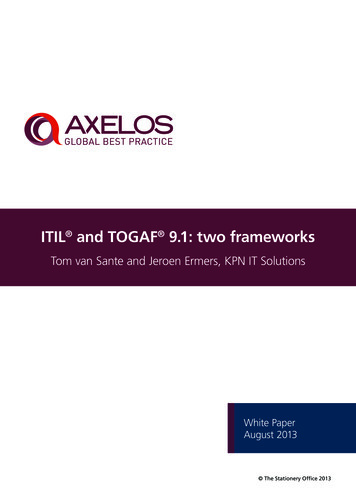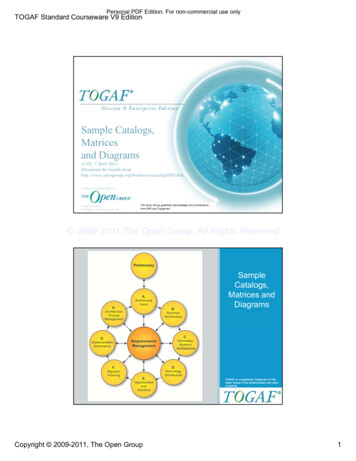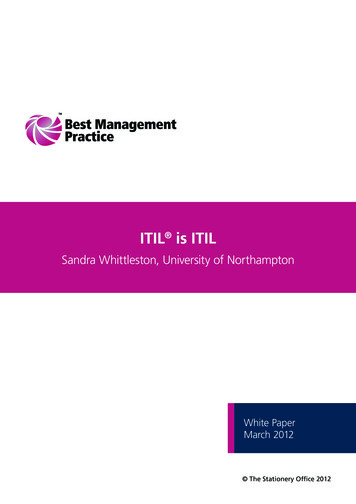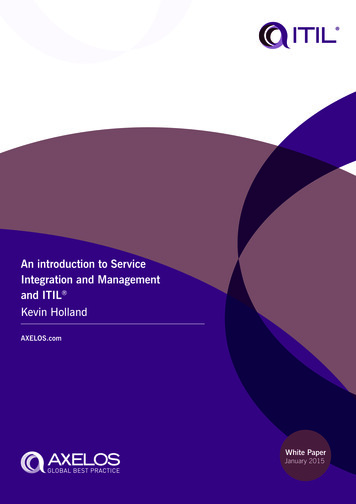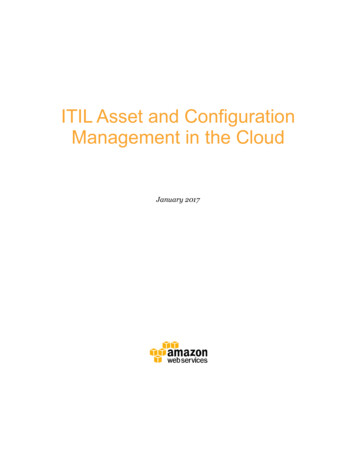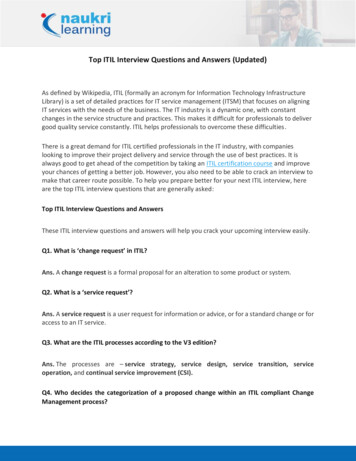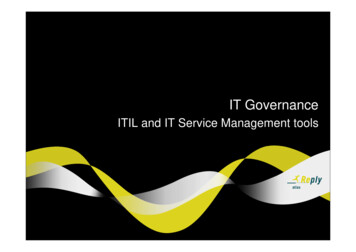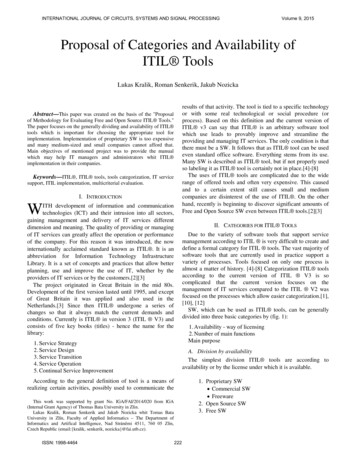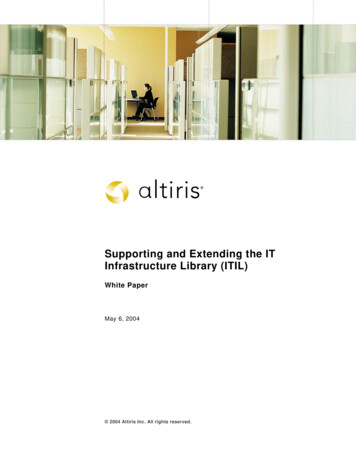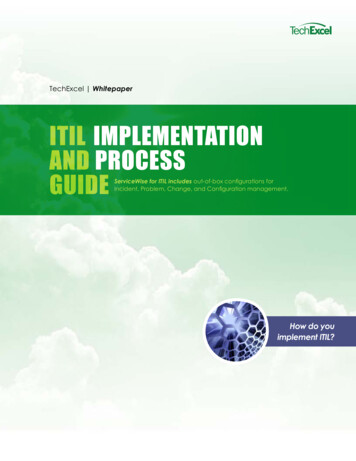
Transcription
TOGAF and ITIL A White Paper by:Serge ThornMerck Serono International SAJune 2007
TOGAF and ITIL Copyright 2007 The Open GroupAll rights reserved. No part of this publication may be reproduced, stored in aretrieval system, or transmitted, in any form or by any means, electronic,mechanical, photocopying, recording, or otherwise, without the priorpermission of the copyright owners.Boundaryless Information Flow and TOGAF are trademarks and MakingStandards Work , The Open Group , UNIX , and the “X” device areregistered trademarks of The Open Group in the United States and othercountries. All other trademarks are the property of their respective owners.ITIL is a registered trademark of the Office of Government Commerce, anoffice of the UK Treasury.TOGAF and ITIL Document No.:W071Published by The Open Group, June 2007Any comments relating to the material contained in this document may besubmitted to:The Open Group44 Montgomery St. #960San Francisco, CA 94104or by email to:ogpubs@opengroup.orgwww.opengroup.orgA White Paper Published by The Open Group2
TOGAF and ITIL Contentswww.opengroup.orgExecutive Summary4Introduction5The ADM9Enterprise Continuum12Components of the ADM13Annex: TOGAF/ITIL Mapping21About the Author26About The Open Group26A White Paper Published by The Open Group3
TOGAF and ITIL Boundaryless Information Flow achieved through global interoperabilityin a secure, reliable, and timely mannerExecutive SummaryThis White Paper considers how the Information Technology Infrastructure Library(ITIL) and The Open Group Architecture Framework (TOGAF) can be used together,with a detailed comparison and mapping between the two. The approach taken isbased on flagging all paragraphs in TOGAF 8.1.1 which may refer to one of the ITILprocesses. As an annex, all chapters and paragraphs are numbered and refer to theseprocesses and underlying concepts. When appropriate, explanations and diagramshave been included.ITIL is a customizable framework outlining worldwide accepted best practices for ITService Management (ITSM). ITIL addresses the organizational structure and skillrequirements for an IT organization by presenting a comprehensive set ofmanagement procedures with which an organization can manage its IT operations.The concepts within ITIL support IT service providers in the planning of consistent,documented, and repeatable processes that improve service delivery to the business.TOGAF is a framework and a method for performing enterprise architecture.www.opengroup.orgA White Paper Published by The Open Group4
TOGAF and ITIL IntroductionITIL and TOGAF are both architecture frameworks, but they address different concerns. ITIL is primarilyfocussed on the delivery of IT services, and TOGAF is a methodology and set of tools for developing anenterprise architecture. TOGAF should be considered as being on top of ITIL as it covers the productconception lifecycle, and ITIL as the way product services are managed for users and customers.ITILThe Information Technology Infrastructure Library (ITIL) is the most widely accepted approach to ITService Management (ITSM) in the world. ITIL provides a cohesive set of best practices, drawn from thepublic and private sectors internationally. It is supported by a comprehensive qualifications scheme,accredited training organizations, and implementation and assessment tools.ITIL facilitates the delivery of high-quality IT services. ITIL outlines an extensive set of managementprocedures that are intended to support businesses in achieving both quality and value – in a financial sense –in IT operations. These procedures are supplier-independent and have been developed to provide guidanceacross the breadth of IT infrastructure, development, and operations.ITIL is published in a series of books (hence the term “Library”), each of which covers a core area within ITmanagement. ITIL Version 2 consolidates the publications into logical “sets” that group related processguidelines into the different aspects of IT management, applications, and services.While the service management sets (Service Support and Service Delivery) are by far the most widely used,circulated, and understood of ITIL publications, ITIL provides a more comprehensive set of practices as awhole. Proponents believe that using the broader library provides a comprehensive set of guidance to link thetechnical implementation, operations guidelines, and requirements with the strategic management, operationsmanagement, and financial management of a modern business.Planning to ImplementService ManagementTheBusinessService gementApplications Managementwww.opengroup.orgTheTechnologyA White Paper Published by The Open Group5
TOGAF and ITIL The eight ITIL books and their disciplines are as follows.The IT Service Management sets: Service Support Service DeliveryOther operational guidance: ICT Infrastructure Management Security Management The Business Perspective Application Management Software Asset ManagementTo assist with the implementation of ITIL practices, a further book was published providing guidance onimplementation (mainly of service management): Planning to Implement Service ManagementService SupportSecurity ManagementApplication ManagementService DeliveryThe Business Perspective(Coming Soon)ICT InfrastructureManagementPlanning to ImplementService ManagementITIL is built around a process-model-based view of controlling and managing operations. The ITILrecommendations were developed in the 1980s by the UK Government's CCTA in response to growingdependence on IT and a recognition that without standard practices, government agencies and private sectorcontracts were independently creating their own IT management practices and duplicating effort within theirInformation and Communications Technology (ICT) projects, resulting in common mistakes and increasedcosts. In April 2001, the CCTA was merged into the Office of Government Commerce (OGC), which is anoffice of the UK Treasury.www.opengroup.orgA White Paper Published by The Open Group6
TOGAF and ITIL One of the primary benefits claimed by proponents of ITIL within the IT community is its provision ofcommon vocabulary, consisting of a glossary of tightly defined and widely agreed terms. A new andenhanced Glossary has been developed as a key deliverable of ITIL Version 3 (also known as the ITILRefresh Project).For further details of the ITIL best practices, please refer to the books mentioned above.TOGAFThe Open Group Architecture Framework (TOGAF) is a framework – a detailed method and a set ofsupporting tools – for developing an enterprise architecture. It may be used freely by any organizationwishing to develop an enterprise architecture for use within that organization.TOGAF was developed by members of The Open Group, working within the Architecture Forum(www.opengroup.org/architecture). The original development of TOGAF Version 1 in 1995 was based onthe Technical Architecture Framework for Information Management (TAFIM), developed by the USDepartment of Defense (DoD). The DoD gave The Open Group explicit permission and encouragement tocreate TOGAF by building on the TAFIM, which itself was the result of many years’ development effort andmany millions of dollars of US Government investment.Starting from this sound foundation, the members of The Open Group Architecture Forum have developedsuccessive versions of TOGAF each year and published each one on The Open Group public web site.TOGAF and ITIL PositioningTOGAF guarantees a consistency for the building of new products or services and addresses businessrequirements. ITIL guarantees the consistency of services between them through the use of standardprocesses, such as Change Management. TOGAF can be based on an enterprise architecture repository andITIL can be based on a Configuration Management Database (CMDB).www.opengroup.orgA White Paper Published by The Open Group7
TOGAF and ITIL This document is based on ITIL Version 2 and TOGAF 8.1.1. It is assumed that readers are familiarwith the two frameworks and their various concepts.The comparison is mainly done between ITSM (Service Support and Service Delivery) and the four mainparts of the TOGAF document: PART I (Introduction): This part provides a high-level introduction to some of the key concepts behindenterprise architecture and in particular the TOGAF approach. PART II (Architecture Development Method): This is the core of TOGAF. It describes the TOGAFArchitecture Development Method (ADM), a step-by-step approach to developing an enterprisearchitecture. PART III (Enterprise Continuum): This part describes the TOGAF Enterprise Continuum, a virtualrepository of architecture assets, which includes the TOGAF Foundation Architecture, and the IntegratedInformation Infrastructure Reference Model (III-RM). PART IV (Resources): This part comprises the TOGAF Resource Base, a set of tools and techniquesavailable for use in applying TOGAF and the TOGAF ADM.The comparison starts from TOGAF and moves up into the ITIL best practices. When appropriate,definitions are included in order to facilitate the reading and to detail the relationship. Chapters thatare not relevant to the comparison are not mentioned.An annex is included at the end of the document which precisely maps the chapters and paragraphs to thevarious ITIL processes.www.opengroup.orgA White Paper Published by The Open Group8
TOGAF and ITIL The ADMThe TOGAF Architecture Development Method (ADM) is the result of continuous contributions from alarge number of architecture practitioners. It describes a method for developing an enterprise architecture,and forms the core of TOGAF. It integrates elements of TOGAF – as well as other available architecturalassets – to meet the business and information technology needs of an organization.Architectural assets can also be software and hardware components, people, and even documentation. InITIL, the Configuration Management Database (CMDB) is the database which holds a record of allConfiguration Items (CIs) associated with IT infrastructure.The infrastructure includes hardware, software, and any associated documentation.A CI is a component of an infrastructure or item, such as a Request For Change (RFC), associated with aninfrastructure that is (or is to be) under the control of Configuration Management.According to ITIL, a CMDB manages: Hardware, including network components, where relevant System software, including operating systems Business systems (custom-built applications) Software packages Database products Physical databases Environments Feeds between databases, applications, and EDI links Configuration baselines Software releases Configuration documentation (e.g., system and interface specifications, licenses, maintenanceagreements, Service Level Agreements (SLAs), decommissioning statement) Change documentation, deviations, and waivers Other resources (e.g., users, suppliers, contracts) Other documentation (e.g., IT business processes, workflow, procedures) Network components Service management components and records (such as capacity plans, IT service continuity plans,incidents, problems, known errors, RFCs, etc.)www.opengroup.orgA White Paper Published by The Open Group9
TOGAF and ITIL The CMDB is the repository which supports the ITIL services from an operational perspective. AnEnterprise Architecture Repository is used to also store the reference patterns and the Architecture BuildingBlocks and is used during the architecture development process. From there, two different approaches couldbe taken into consideration depending on the IT Service Management (ITSM) and enterprise architecturematurity of the company and the tools already in place.Scenario 1: The company owns an Enterprise Architecture Repository and a CMDBAs vendors, the CMDB does not really have a predefined meta-data model; the latest should be aligned withthe Enterprise Architecture Repository existing models. This would guarantee consistency between the twodomains.Scenario 2: The company owns an Enterprise Architecture Repository (not mandatory)and a CMDB, and extends it with Architectural ViewsSome companies may be tempted to extend the meta-model of their CMDB. Some vendors provide tools toallow the CMDB model to be extended. This would allow adding new tables and views.www.opengroup.orgA White Paper Published by The Open Group10
TOGAF and ITIL Therefore, a CMDB could be also used to store the architectural assets of the enterprise architecture. Themeta-model of a CMDB being extended could integrate the missing information related to the enterprisearchitecture.The goals of Configuration Management are: To identify, record, and report on all IT components that are under the control and scope ofConfiguration Management To provide a logical model of the infrastructure or a service by identifying, controlling, maintaining, andverifying the versions of CIs in existence in the CMDBThe ADM method could integrate the Configuration Management process in order to populate “the CMDBrepository” with reference architecture, models, and patterns, and also architecture assets.www.opengroup.orgA White Paper Published by The Open Group11
TOGAF and ITIL Enterprise ContinuumThe TOGAF Enterprise Continuum provides a framework and context for the leveraging of relevantarchitecture assets in executing the ADM. These assets may include architecture descriptions, models, andpatterns taken from a variety of sources. At relevant places throughout the ADM, there are reminders toconsider which architecture assets from the Enterprise Continuum the architect should use, if any. In somecases – for example, in the development of a Technology Architecture – this may be TOGAF's ownFoundation Architecture. In other cases – for example, in the development of a Business Architecture – itmay be a reference model for e-Commerce taken from the industry at large.The Enterprise Continuum with the architecture assets can be associated with the Configuration ManagementDatabase (CMDB) and be linked as previously said to the Configuration Management process. The work inprogress could be indicated in the Configuration Item (CI) as the status changes over time. The CMDB couldalso be considered as a virtual repository for an enterprise architecture.The IT Governance process should refer to ITIL and support the Configuration Management process toupdate the Enterprise Continuum accordingly.Building blocks could also be associated with groups of CIs.The scoping of the architecture can be linked to the scoping exercise of the Configuration Managementprocess which is the range of responsibility covered by the process. The scope and details of the CMDBshould consider the vertical scoping of the architecture. The CI level, which is the degree of detail selected todescribe each CI, could take into consideration architectural needs.www.opengroup.orgA White Paper Published by The Open Group12
TOGAF and ITIL TOGAF ComponentsPreliminary Phase: Frameworks and PrinciplesThe IT Governance Strategy as an Input (when pre-existing) should identify whether it includes IT ServiceManagement (ITSM). IT governance can have different flavors. Ideally, ITSM should be considered.Phase B: Business ArchitectureBusiness Architecture is a formal documentation of the lines of business, their support functions, and theirrelationship to each other. After the architecture has been documented, it is systematically analyzed toexamine the functions (services) required by business and to align the enterprise technology with thosefunctions.Service Level Management is the name given to the processes of planning, coordinating, drafting, agreeing,monitoring, and reporting on Service Level Agreements (SLAs), and on the ongoing review of serviceachievements to ensure that the required and cost-justifiable service quality is maintained and graduallyimproved.The process goal is to maintain and improve IT service quality through a constant cycle of agreeing,monitoring, and reporting to meet the customer’s business objectives.The definition of new services or their elimination in a Business Architecture should be associated with theService Level Management process.Each business service should be mapped to the Service Catalog (the document where the IT servicesavailable to the customer are defined).Each business service should be linked to an SLA, which is a written agreement between an IT serviceprovider and the IT customer. SLAs are used for internal customers.Phase C: Information Systems Architecture – Data ArchitectureInformation Systems Architecture programs are typically driven from the corporate or group level, and areoften inspired by the need to consolidate information (e.g., customer, product, and employee) across thecompany.Information Systems Architecture is the art and science of organizing information and interfaces to helpinformation seekers solve their information needs efficiently and effectively, primarily within networked andweb-based environments.The qualitative criteria should also be associated with the Service Level Management process and be basedon Operational Level Agreements (OLAs), which are agreements between two internal IT areas/departments;e.g., Network Management and Operations.Phase C: Information Systems Architecture – Applications ArchitectureAlso called the Solutions Architecture, the Applications Architecture focuses on three separate dimensions –data, processes, and technology – and five sequential levels of detail or views – the corporate view (orballpark), the process owner’s view, the designer’s view, the builder’s view, and the programmer’s view.www.opengroup.orgA White Paper Published by The Open Group13
TOGAF and ITIL An Applications Architecture, at the conceptual level, gives us a set of well-defined and modularizedapplications, integrated through a set of common databases without redundancy that fully support the futurebusiness challenges of the integrated enterprise.The qualitative criteria should also be associated with the Service Level Management process and be basedon OLAs.Phase D: Technology ArchitectureThe Technology Architecture is primarily concerned with enterprise-wide integration issues, describing in avendor-independent manner the technology-related entities and relationships that need to be managed acrossthe enterprise. (Technology-related entities may include platforms, information appliances, softwareapplications or parts, information access and storage, networking, and the external and internal users of theinformation systems.)The Baseline Technology Architecture could be contained in the Configuration Management Database(CMDB) and the activities associated related to the Configuration Management process. ArchitectureBuilding Blocks could be linked to business services using the IT Service Management (ITSM) notion of“relationships”, which is the description of the interfaces that exist between Configuration Items (CIs) in theinfrastructure.www.opengroup.orgA White Paper Published by The Open Group14
TOGAF and ITIL The Architecture Building Blocks could be new types of CI in the CMDB. If possible, the meta-model of theCMDB could be extended and a new category created.Standard categories include: Programs/Projects Services Systems Hardware Software Documentation Environment People DataA new category could be created named “Architecture Building Blocks”. An IT service could also haverelationships with one-to-many Architecture Building Blocks. This will be managed through theConfiguration Management process.In the Target Technology Architecture, consideration will have to be given to the Service Catalog. ServiceLevel Management will have to be taken into consideration (the TOGAF Technical Reference Model (TRM)service grouping and service portfolio) when the gap analysis of services (matrix) is done.Documentation related to Architecture Building Blocks and documentation of services will become CIs.Target services will amend the Service Catalog when appropriate. There should be a strong relationshipbetween the latter and the portfolio of services.Change requests related to: The Architecture Continuum When the Business Architecture needs to be transformed Data or applicationwill be based on Requests For Change (RFCs) and the Change Management process.The process should ensure that standardized methods and procedures are used for efficient and prompthandling of all changes to minimize the impact of change-related incidents and improve day-to-dayoperations. A change is an action that results in a new status for one or more IT infrastructure CIs.Phase E: Opportunities and SolutionsThis phase will refer to three processes: Change Management Release Managementwww.opengroup.orgA White Paper Published by The Open Group15
TOGAF and ITIL Financial ManagementThe move or the migration from a baseline environment to the target should be through the use of a ProjectManagement methodology, but also the Release Management process.Release Management takes a holistic view of a change to an IT service and should ensure that all aspects of arelease, both technical and non-technical, are considered together. Among other activities, ReleaseManagement will consist of the release policy, the release (migration) planning, the design and build of therelease, the testing, etc. This process should therefore be used for any new deployed business opportunities.The costs will also have to be taken into consideration and Financial Management used as a process, the goalbeing to provide cost-effective stewardship of the IT assets and resources used in providing IT services.Phase F: Migration PlanningThis phase is similar to the previous one and also refers to the same processes: Change Management, ReleaseManagement, and Financial Management. However, an additional process will have to be taken intoconsideration: Service Level Management.Once the project implementation is defined, new services will be added or removed from the Service Catalogand, in parallel, SLAs-OLAs will be updated/added/removed.Phase G: Implementation GovernanceThe implementation and deployment process should be done through the Release Management process.www.opengroup.orgA White Paper Published by The Open Group16
TOGAF and ITIL Phase H: Architecture Change ManagementAs mentioned earlier, a change is an action that results in a new status for one or more IT infrastructure CIs.The concept can be also used for any architecture change and it would be recommended to use the sameChange Management process which covers several activities such as: RFC, change logging, and filtering (acceptance) Allocation of priorities and categorization Change Advisory Board (CAB) meetings(It should be noted that this committee should also have a member from the Enterprise Architectureteam.) There should also be some synergies with the Architecture Board. The approval from thearchitects should be a pre-requisite before submitting an RFC to the CAB. Impact and resource assessment Change approval Change scheduling Change building, testing and implementation Change review Reviewing the Change Management process for efficiency and effectivenesswww.opengroup.orgA White Paper Published by The Open Group17
TOGAF and ITIL Architecture Requirements ManagementRequirement Management is often associated with Change Management.Requirements Management is the science and art of gathering and managing user, business, technical,functional, and process requirements within a product development project. The project could be for a newconsumer product, a web site, a system, or a software application all requiring architecture modifications.Requirements should be managed by the Change Management process.Input and Output DescriptionsThe Request for Architecture Work containing budget information or financial constraints should refer to theFinancial Management process.Business Architecture, business system description, and product information should refer to the ServiceLevel Management process; specifically the Service Catalog and/or the SLAs.Baseline Architecture, IT system, and architecture descriptions can be found in the CMDB and refer toConfiguration Management.The Architecture Contract may refer to an SLA or an OLA.The Enterprise ContinuumThe constituents such as the Architecture and the Solutions Continuum will obviously be based on theCMDB and the Configuration Management process.The common systems and industry architecture can refer to a generic problem domain. Problem Managementis a process whose goal is to minimize the adverse impacts of incidents and problems on the business that arecaused by errors in the IT infrastructure and to prevent recurrence of incidents related to these errors. Thearchitecture requirements could be the results of the root cause and initiate action to remove the error.Product and Services, System Solutions, and Industry Solutions should refer to the Service LevelManagement process.Foundation Architecture: Technical Reference Model (TRM)As previously stated, Configuration Management is a key process for the maintenance of the EnterpriseContinuum and its constituents. The Technical Reference Model (TRM) should be updated through thatprocess and could be considered as a view of the CMDB. A TRM component could be an aggregation of CIs.Also, it would be a good idea to align the taxonomy whenever possible to the ITIL Glossary.Application Software, Business Applications, Infrastructures Applications, Application Platform Taxonomy,and Service Categories should refer to the Service Level Management process and specifically the ServiceCatalog, SLAs, and OLAs.Communication Infrastructure, Application Platform Interface, and Communication Infrastructure Interfacewill refer to Configuration Management.It needs to be specified that Service Categories is highly detailed and could be the source for the definition ofa Service Catalog at the IT department level. Some operational departments develop a catalog of serviceswww.opengroup.orgA White Paper Published by The Open Group18
TOGAF and ITIL related to their support to other IT units. OLAs can therefore refer to this departmental catalog of servicessuch as described in the Application Platform Service Categories.The service qualities presently identified in the TRM taxonomy should refer to the following processes: Availability Management for availability Capacity Management for performance IT service continuity for recoverabilityDetailed Platform TaxonomySystem and Network Management Services: Configuration Management should refer to the ITIL process. Performance Management should refer to Capacity Management, which is the process which ensures thatall the current and future capacity and performance aspects of the business requirements are providedcost-effectively. Availability and Fault Management should refer to Availability Management, which is the process thatoptimizes the capability of the IT infrastructure services and supporting organization to deliver a costeffective and sustained level of availability enabling the business to meet its objectives. Accounting Management should refer to Financial Management. Security Management can refer to the dedicated volume on ITIL Security Management. Backup and Restore should be covered by IT Service Continuity. Online disk management is an activity from Capacity Management. Capacity Management should refer to the ITIL process. Software Installation should refer to Release Management. Trouble Ticketing should refer to Incident Management, which is the process which restores normalservice operation as quickly as possible and minimizes the adverse impact on business operations.Object Oriented Provision of Services: Change Management should refer to the ITIL process.Foundation Architecture: Integrated Information Infrastructure Reference Model (III-RM)As this is a derivation of the TRM, Configuration Management will also be the main process used. Hereagain Application Platform will refer to Service Level Management and quality to SLAs.Architecture BoardIn the agenda, the reference to RFCs should also be part of the Change Management process. When a CABexists for that process, members of the Architecture Board should be added when applicable. Complianceand assessment should be taken into consideration in the Service Level Management process.www.opengroup.orgA White Paper Published by The Open Group19
TOGAF and ITIL Building BlocksThe creation of the Architecture Building Blocks should be in the Configuration Management process asalready described above.GlossaryAlignment with the ITIL Glossary would be appropriate.www.opengroup.orgA White Paper Published by The Open Group20
TOGAF and ITIL Annex: TOGAF/ITIL MappingIn this annex, all chapters and paragraphs in TOGAF 8.1.1 are listed with reference to the relevant ITILprocess and/or underlying concept.TOGAFCommentsITILArchitecture AssetsConfigurationManagementComments3. Introduction to theADM3.1.2The ADM and theEnterpriseContinuumRepository thatincludes referencearchitecture,models, ressConfigurationManagementCI's statusIT Continuum with allassetsConfigurationManagementRe-usable ent3.6Scoping theArchitectureVertical ScopeConfigurationManagementCMDB scopingVertical Scope/Level of DetailConfigurationManagementCMDB scopingIT 4. Preliminary Phase:Frameworks andPrinciples4.36. Business Architecture6.26.2.5Eliminated or NewServicesService LevelManagementService C
enterprise architecture and in particular the TOGAF approach. PART II (Architecture Development Method): This is the core of TOGAF. It describes the TOGAF Architecture Development Method (ADM), a step-by-step approach t
